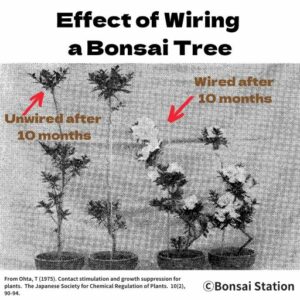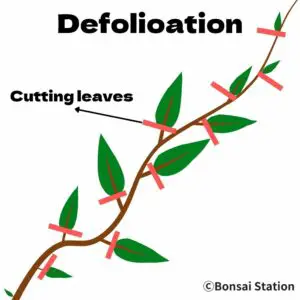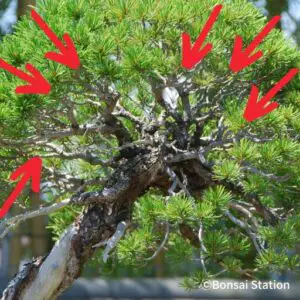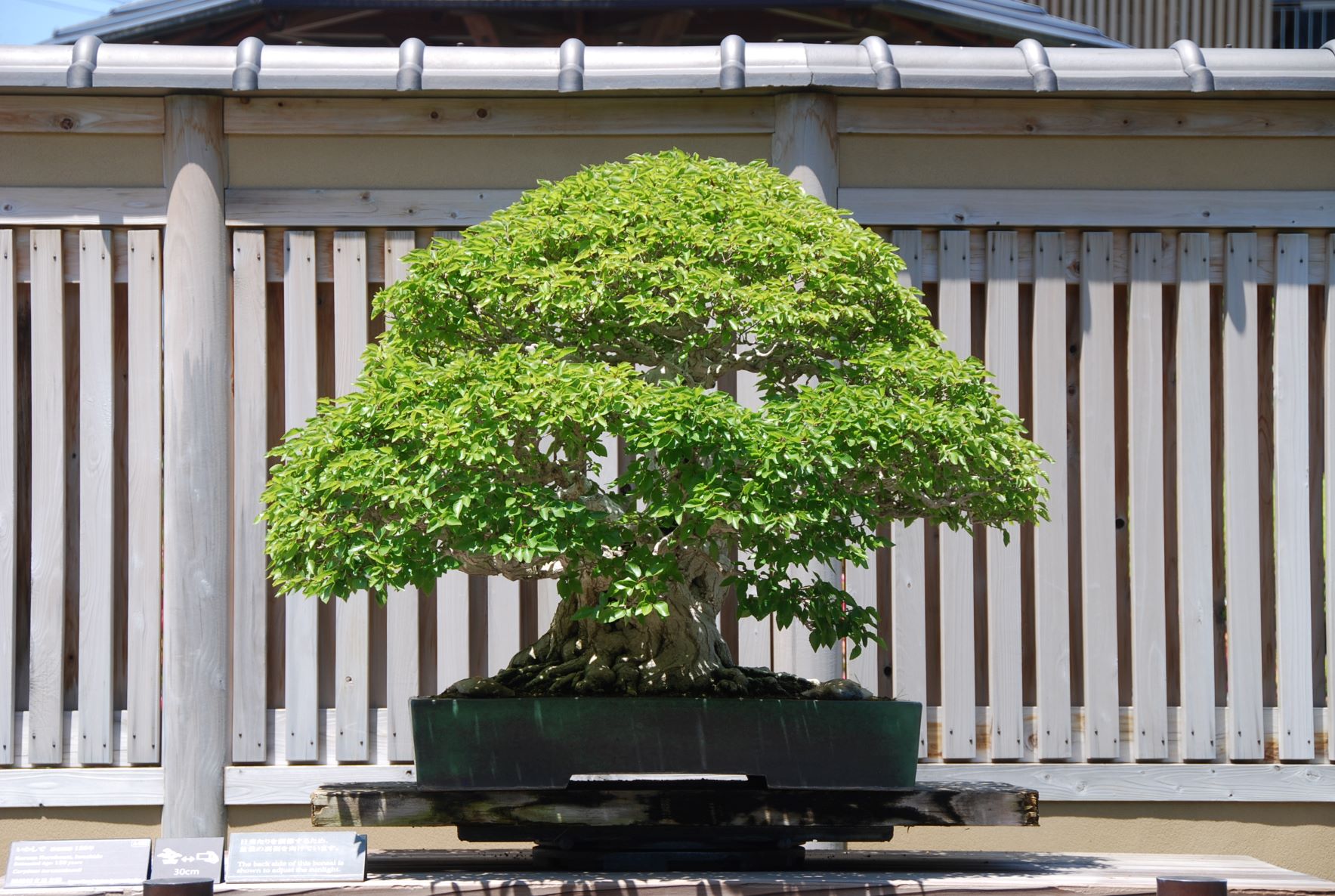You might be wondering how bonsai trees stay so small.
By restraining the root system in a shallow pot as well as putting stress by wiring and defoliation, we can significantly limit a tree’s growth and artificially mature it before it reaches its fullest potential.
How do bonsai trees stay so small?
There are two ways to make a bonsai tree stay small:
- Restraining the growth of the root system
- Stressing the aerial part by wiring and defoliation
Let me explain in detail.
Confined Root System

confined root system
What do roots need to grow?
Plant roots need the following to survive and grow:
- air (gas exchange)
- water
- temperature
- nutrients (carbohydrates and minerals)
- soil
- microbes and
- space.
Growing a plant in a bonsai pot gives everything above except for space to grow roots.
What happens when roots do not have space to grow?
When the root system is restricted in a small rooting volume, trunks, branches and leaves become smaller.
Roots rely on plant aerial portions (i.e. plants above soil) for photosynthesis, while plant aerial portions rely on the roots for water, nutrients, support, and hormones. In general, as pot size decreases, plant leaf area, shoot biomass and root biomass decrease as growth rates of shoots and roots are interdependent.
Isn’t putting in a small pot bad for the plant’s health?
Secret to the soundness of bonsai trees despite their restricted root volume lies in root pruning when repotted.
Root pruning uses a highly regenerative nature of root system to control the plant size and vigor of its growth. Researchers found out that damaging roots by cutting them induces plant growth hormone called auxin in the roots, which stimulates robust root regeneration.
Depending on the species, a bonsai tree is to be repotted every one to 3 years and roots are pruned at the same time. That means bonsai trees’ root system is fully regenerated in a relatively short period of time and thus kept young and healthy.
This regeneration of the root system keeps bonsai trees healthy although the roots are confined in a small space.
Wiring and Defoliation
What happens when a bonsai tree is stressed?
When a plant is stressed, it induces a plant hormone called ethylene. Ethylene is a multifunctional hormone that regulates both the growth and senescence (aging) of plants; germination, development of leaves and ripening of fruits. It also promotes, inhibits and induces aging of plants.
Ethylene act as a defense mechanism for plants. When a bonsai tree is wired, ethylene is induced to protect itself from an adverse environment.
What happens when a bonsai tree is wired?
Wiring bonsai trees make them mature without full growth.
According to a research where the trunk of azalea was wired, branches ramified (multiple small branches developed) very quickly and the flowers bloomed 10 months after wiring (as shown in the picture below on the right).
The one without wiring grew vigorously but developed fewer branches and no flower (as shown in the picture below on the left).

Effect of wiring a bonsai tree
What happened to the wired azalea bonsai here is that the stress caused by bending the branches increased the production of ethylene, which inhibited it from continuously growing upwards. It instead promoted multiple small branches to develop and the trunk to thicken.
In other words, the wired bonsai tree matured without full growth.
What happens when a bonsai tree is defoliated?
Defoliation makes a bonsai tree compact, with more branches and small leaves.

Defoliation
Defoliation involves cutting all/some; whole/ part of leaves to force a tree to produce new leaves. The main reasons for defoliation are to adjust the vigor of the tree, increase the number of branches (i.e. ramification), and make it compact as well as look older than it is.
Defoliation makes the bonsai tree compact
Bonsai trees should have short but finely divided small branches to look like a full-size tree.

There are various ways to make a bonsai tree compact such as restraining water/ fertilizer/ sunlight and putting in small pots. But by far, defoliation has the most desired effect in a shorter period of time.
When leaves are cut, new fine branches with short nodes are produced as the vigor of the tree is suppressed and the direct sunlight in the absence of leaves stimulates buds to develop new branches.
If leaves of only strong branches are removed, weaker branches thicken thus averaging the overall vigor of branches.
Defoliation makes the leaves smaller
Bonsai trees should have small leaves to match the height of the tree. Cutting leaves weakens the strength of the branches, and the next leaves produced are smaller and the branches become finer.
Are bonsai trees mini trees?
Bonsai trees are ordinary trees and not genetically mutated ones that grow small. Special techniques such as pruning, defoliation, wiring and potting in a shallow pot make them a miniature size trees.
What happens if you let a bonsai tree grow?
As bonsai trees are ordinary trees, they will grow to be an ordinary size when it is planted in the ground, whether it is a few feet or a few dozen feet.
On the other hand, if bonsai trees are left to grow in shallow bonsai pots, they might grow more than usual bonsai trees but not as much as those planted in the ground. The roots need abundant space to grow to be at trees’ fullest; if the growth of roots is restrained, so is the growth of the trunk and branches.
—–
Reference:
Ohta, T (1975). Contact stimulation and growth suppression for plants. The Japanese Society for Chemical Regulation of Plants. 10(2), 90-94. (link here)
Xu, D. et. al. YUCCA9-Mediated Auxin Biosynthesis and Polar Auxin Transport Synergistically Regulate Regeneration of Root Systems Following Root Cutting. Plant and Cell Physiology. Volume 58, Issue 10, October 2017, Pages 1710–1723 (link here)
Factors Affecting Root Growth in the Landscape. Integrated Pest Management, University of Missouri. (link here)
NeSmith, D., et. al. The effect of container size. Hort Technology. 8(4), 1998 (link here)
Iqbal, N. et. al. Ethylene Role in Plant Growth, Development and Senescence: Interaction with Other Phytohormones. Frontier in Plant Science. April 2017. (link here)
Xu, Y. et. al. Mitochondrial function modulates touch signaling in Arabidopsis thaliana. The Plant Journal. Dec. 2018. (link here)



